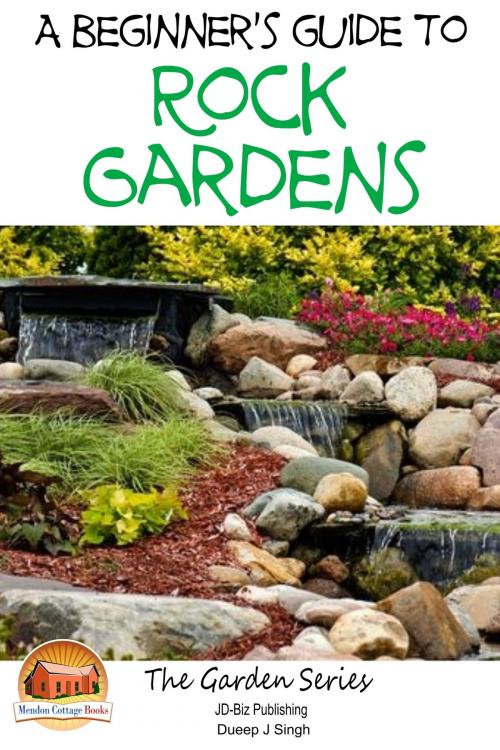| Author: | Dueep J. Singh | ISBN: | 9781310574139 |
| Publisher: | Mendon Cottage Books | Publication: | January 28, 2015 |
| Imprint: | Smashwords Edition | Language: | English |
| Author: | Dueep J. Singh |
| ISBN: | 9781310574139 |
| Publisher: | Mendon Cottage Books |
| Publication: | January 28, 2015 |
| Imprint: | Smashwords Edition |
| Language: | English |
Table of Contents
A Beginner’s Guide to Rock Gardens
Introduction
Wrong Way Of Placing Rocks
The Right Way to Place Rock Stones
Good Rock Work-
Flat Ground
Wall
Stones on Slopes
Choosing the Best Soil
Building Your Rock Garden
Planting Your Rock Plants
Maintenance
Conifers
Bulbs
List of Rock Plants, depending on the Particular Conditions and Places
Rock Plants For Walls
Crazy paving plants –
Conclusion
Author Bio
Publisher
Introduction
Rock gardens have been part of landscaping and gardening lore for millenniums. In the East Japanese rock gardens or Zen gardens have been places where people could meditate in serene and harmonious surroundings.
Why are more people designing their own gardens incorporating at least one rock garden in the design? Even if the rock garden is quite small, it is going to add a touch of distinction to the landscaping of your garden.
In Japan, rock gardens were normally built as dry landscape gardens, where a number of landscapes were made up of natural compositions made from natural products incorporated into a landscape. These natural items included bushes, trees, Moss, water, rocks and sand. One believes that the concept of rock gardening originated in China, especially when the ancient religion of Shintoism spoke about places of harmony where one could commune with nature and the spirit in serenity. These were normally made in monasteries, where they could be seen from one focal point, like say the porch of the head priest of the monastery.
These dry Landscape gardens which you call a Zen garden in Japan were built to be seen from one viewpoint, with the walling closed around it in ancient times. Nowadays they stretch on for miles incorporating all the natural features available and present in the area to make up harmonious surroundings.
Japanese Zen gardens go back to 784 BC. Chinese gardens have been around for even longer. The incorporation of gravel and white sand in a Zen or rock garden was an important feature. These were the symbol of distance, emptiness, purity, white space and water. All these symbols were supposed to aid in meditation. White sand and gravel used harmoniously together were also used around temples, shrines and palaces.
Table of Contents
A Beginner’s Guide to Rock Gardens
Introduction
Wrong Way Of Placing Rocks
The Right Way to Place Rock Stones
Good Rock Work-
Flat Ground
Wall
Stones on Slopes
Choosing the Best Soil
Building Your Rock Garden
Planting Your Rock Plants
Maintenance
Conifers
Bulbs
List of Rock Plants, depending on the Particular Conditions and Places
Rock Plants For Walls
Crazy paving plants –
Conclusion
Author Bio
Publisher
Introduction
Rock gardens have been part of landscaping and gardening lore for millenniums. In the East Japanese rock gardens or Zen gardens have been places where people could meditate in serene and harmonious surroundings.
Why are more people designing their own gardens incorporating at least one rock garden in the design? Even if the rock garden is quite small, it is going to add a touch of distinction to the landscaping of your garden.
In Japan, rock gardens were normally built as dry landscape gardens, where a number of landscapes were made up of natural compositions made from natural products incorporated into a landscape. These natural items included bushes, trees, Moss, water, rocks and sand. One believes that the concept of rock gardening originated in China, especially when the ancient religion of Shintoism spoke about places of harmony where one could commune with nature and the spirit in serenity. These were normally made in monasteries, where they could be seen from one focal point, like say the porch of the head priest of the monastery.
These dry Landscape gardens which you call a Zen garden in Japan were built to be seen from one viewpoint, with the walling closed around it in ancient times. Nowadays they stretch on for miles incorporating all the natural features available and present in the area to make up harmonious surroundings.
Japanese Zen gardens go back to 784 BC. Chinese gardens have been around for even longer. The incorporation of gravel and white sand in a Zen or rock garden was an important feature. These were the symbol of distance, emptiness, purity, white space and water. All these symbols were supposed to aid in meditation. White sand and gravel used harmoniously together were also used around temples, shrines and palaces.















